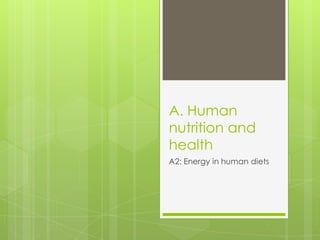
A2 Energy In Human Diets
- 1. A. Human nutrition and health A2: Energy in human diets
- 2. Energy in diets Cell respiration involves the release of energy from foods such as fat, carbohydrate or protein. Foods eaten in bulk to supply energy are called staple foods. Human societies are very diverse in their choice of staple energy sources.
- 3. What is food energy and how is it measured? Humans are autotrophs and get energy from organic molecules from other organisms. Typically these are fats, lipids and carbohydrates. One food Calorie = 1kcal or 1000 cal One calorie is the energy needed to raise 1g of water by 1°C One food Calorie = 4.18kJ (kilo joules) SI unit
- 4. Compare the energy content per100 g of carbohydrate, fat and protein Energy in 100 g Fats Carbohydrates Proteins 4 000 kJ 1 760 kJ 1 720 kJ 956kcal 421kcal 411kcal
- 5. How is food energy metabolized?
- 6. Why are fats so energy rich? Energy in 100 g Fats Carbohydrates Proteins 4 000 kJ 1 760 kJ 1 720 kJ 956kcal 421kcal 411kcal
- 7. Let’s check the food label again! What percentage calories from fat are in this burger? (295/563) x 100 = 52.4% Whatpercentage of fat by weight is in this burger? (33/219) x 100 = 15.1%
- 8. How much energy do we need? Energy needs vary according to size, age, gender and level of activity, but you can calculate the amount you take in and the amount you need. Amount taken in – amount used = amount stored
- 9. Staple diets vary by geographical region and culture Availability and sustainability of land are major factors in the food energy source of a population Initiatives like «Golden Rice» can use genetic engineering to supplement staple foods to reduce malnutrition
- 10. Carbohydrate-rich diets Two types: Large amounts of sugar: increase the risk of developing type II diabetes and tooth decay. Large amounts of starch: usually from cereals or root crops (tubers). If digested slowly, it can be a healthy diet. If digested quickly, promtes the development of type II diabetes. All diets with excessive amounts of carbohydrates can cause obesity
- 11. Fat-rich diets They can cause obesity Other consequences depend on the type of fatty acids contained in the fats. Fats, unlike carbohydrates, cannot be used for anaerobic respiration, so they are unsuitable for athletes in strength events, like running and weight lifting.
- 12. Protein-rich diets Protein is only used as an energy source if it is present in the diet in excess or if amounts of carbohydrates and fat are very small. Weight lifters and body builders sometimes have a high-protein diets and they are sometimes used as a method for slimming.
- 13. Eating and apetite Appetite is controlled in the hypothalamus of the brain. Control is both nervous and hormonal: some hormones trigger appetite- stimulating neurons, others trigger appetite- inhibiting neurons. An empty stomach releases the hormone gherin, which triggers appetite-stimulating hormones, leading to hunger. When food enters the stomach, gherin production is stopped, reducing hunger.
- 15. Calculating Body Mass Index (BMI) BMI= body mass (kg) Calculate your BMI height (m) BMI Below 18.5 18.5 – 24.9 25.0 – 29.9 30.0 and above Category Underweight Normal Overweight Obese Limitations of the BMI using this table: Race, gender and age are not considered No distinction is made on body fat/water/muscle composition
- 16. Obesity A BMI of 30.0 or above is catalogued as obesity. In some countries rates of clinical obesity are increasing for many reasons: Availability of cheap, high-energy food (junk food) Large portion sizes served in restaurants (super size) Increase use of vehicles for transport instead of walking Increase in office-based jobs replacing jobs involving physical activity Sedentary recreation (videogames) replacing active recreation (sports)
- 17. Anorexia nervosa - causes Anorexia nervosa is an eating disorder in which the patient severely limits food intake (voluntary starvation). It is a medical condition with complex mental and physiological causes. It is closely associated with body image and meeting aesthetic standards imposed by culture. It is most common in females, but does occur in males.
- 18. Anorexia nervosa - consequences Since the amount of carbohydrates and fats consumed are too small, the body starts breaking down its own proteins. Hair becomes thinner and can drop out. Skin becomes dry and bruises easily Blood pressure is reduced, slow heart rate and poor circulation No ovulation or menstrual cycles and infertility.
